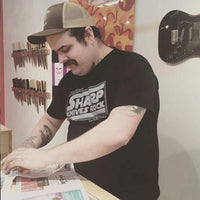
Ceramic Knives, Worth The Hype?
Knives made of materials other than steel are a thing. I’ve seen knives for kids made of bamboo and gimmicky lettuce-cutters hanging in the grocery store made of neon green plastic. It's a common fact that before metal, people were making edged tools from flint, bone, and other stones.
The first time I heard of a ceramic knife was when Timothy Taylor’s chef-protagonist, Jeremy Papier of Stanley Park (2001), replaced his missing Sabatier chef’s knife with an exorbitant Japanese zirconia blade. Of the alternate materials out there, ceramic seems to make the most sense; it’s an insanely hard material that should get stupid sharp and keep its edge forever. Kyocera is a big name in the ceramic knife game; I’ve bought a few over the years and never found them to measure up to the hype.
There are some obvious benefits to these knives. They are ultra-light weight, even compared to an already light Japanese knife, rusting is impossible, and they have come down in price by a lot over the years. The fictional santoku belonging to the Money Paw Bistro’s crips and bloods obsessed chef goes for a whopping $75 now.
The major cons of ceramic knives are that they chip so damn easily and are near impossible to sharpen at home. Remember what I said about hardness? In order to sharpen a blade, you need something even harder to grind it. Only diamonds are technically harder than ceramic—got any diamonds lying around to sharpen your knives? We know that harder steels chip more easily than soft ones, but ceramic is in a whole new zone. Even the most delicate steel knife—SG2 anyone?— is hardier than a ceramic blade.
Strong knife skills are a must for anyone using one of these, any twisting or torquing, even the tiniest slip, will result in a chipped edge. And where are those itty bitty ceramic shards going to end up? Right in your belly. With a ceramic knife, I would avoid any frozen foods, tough skinned or particularly dense vegetables like a squash or sweet potato, woody stemmed herbs, and bones—no matter how small or thin. Careful not to drop a ceramic knife because the blade is no match for a tiled floor and will definitely shatter.
I think ceramic knives would get a 10/10 if they were a lot sharper out of the box. They are advertised for keeping their edge longer than any other knife, but the edge in question isn’t worth keeping. I can forgive a delicate edge for otherworldly sharpness—hell, I make that trade all of the time with my Japanese knives —but this is like bragging that you’re cooking a huge dinner for all of your friends and when they show up, only boiled turnips are on the menu. A collection of high grit diamond plates could be used for maintenance or giving the new edge an overhaul but that’s going to hugely affect the affordability factor. Even your local sharpening wizard won’t be able to tune up a ceramic knife, they generally have to be shipped back to the manufacturer every time they lose their edge.
These guys are great on paper, not so much for going through it though. Give ceramic knives a try if you are among the curious and you find one on a sale rack. They would be best suited for a person who cuts mostly fruit and soft veggies at home—a chef or professional cook will find their knife abused and crippled before the first week is out—a surgeon’s touch is best for these tools; a plastic surgeon, not an orthopedic surgeon.
You’ll find that a more traditional knife made of steel, even Japanese steel, is going to be much more forgiving and easier to maintain in the long term. Sure a ceramic knife will never rust, but it can’t be sharpened easily. If it’s insane edge retention with minimal maintenance you desire, focus your knife search on ‘powdered’ stainless steels like SG2 and R2—I’m a huge fan of Nigara Hamono’s SG2 and Kurosaki san’s Senko lines. Really want to push the limits of sharpness? Look at the Hatsukokoro Haybusa made of the ultra hard HAP40 steel—it’ll stay sharp forever. If you just want a grab knife that keeps an edge well, check out anything from Haruyuki.
Want to learn more about stainless steel knives and why it might be the right choice for you? Read this!





